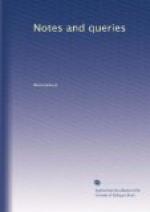“We find strange persons in the Earl’s household (Leicester). Salvador, the Italian chemist, a confidential counsellor, supposed to have departed from this world with many secrets, succeeded by Dr. Julio, who risked the promotion. We are told of the lady who had lost her hair and her nails,” ... “of the Cardinal Chatillon, who, after being closeted with the Queen, returning to France, never got beyond Canterbury; of the sending a casuist with a case of conscience to Walsingham, to satisfy that statesman of the moral expediency of ridding the state of the Queen of Scots by an Italian philtre.”
Where may I turn for the above, more particularly for an account of the lady who had lost her hair and her nails?
H.C.
April 9. 1850.
Lord John Townshend’s Poetical Works.—Can any of your readers inform me whether the poetical works of Lord John Townshend, M.P., were ever collected and published, and, if so, when, and by whom? His lordship, who, it will be remembered, successively represented Cambridge University, Westminster, and Knaresborough, was considered to be the principal contributor to the Rolliad, and the author of many odes, sonnets, and other political effusions which circulated during, the eventful period 1780-1810.
OXONIENSIS.
May 4.
Martello Towers.—Is it the fact that the towers erected along the low coasts of Kent and Sussex during the prevalent dread of the French invasion received their designation from a town in Spain, where they were first built? By whom was the plan introduced into England? Is any account of their erection to be found in any Blue Book of the period?
E.V.
Mynyddyslwyn.—The name of the parish Mynyddyslwyn, in Monmouthshire. This name, so full of Druidic suggestion, was lost from general use at, and anterior to, the incorporation of Wales with England by the statute of Rhudolan. In a list of the names of Welsh parishes at that time, the parish is called The Parish of Tudor ab Howell. Has any reader of the “NOTES AND QUERIES” met with Mynyddyslwyn in any document bearing an earlier date?
D. RHYS STEPHEN.
Abergwyddon.
Three Dukes.—Who were the three Dukes who killed the beadle on Sunday morning, 26th February, 1671, as commemorated by verses in Poems on State Affairs, vol. i. p. 147.?
E.
Bishops and their Precedence.—Bishops, in all Tables of Precedency, have place before the temporal barons. No reason is assigned but it is generally supposed to be from the respect due to{10} the Church and their high calling which might have placed them higher.
Can any of your readers tell where any authority or reason is given by writers upon precedence why the precedence is given to them over the temporal barons? E.
Guineas.—What is the earliest instance of the use of the word guinea as a name for a coin? The common story is, that the piece of twenty-one shillings was so called in the reign of Charles II. from being made of gold from Guinea. What coin is meant in the following receipt?—




